Cova d'es Cuieram, Culleram |
|
Cala San Vicente in Ibiza, encompassed some of the island's oldest history.
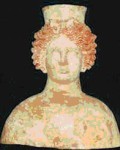
An extraordinary cave, high above the village, about 150 metres in height located in can Quintals property, testifies to a local population in very ancient times.
Called the Cova d'es Cuieram, its contents prove occupation even prior to the arrival of the Greeks, when the island's meagre population worshipped the goddess Tanit.(photo)
Her influence is still well recognized by those who have arrived on the island more recently, and survived - with Tanit's blessing.
From an archaeological point of view, Es Culleram was discovered in 1907 by members of the Ebusitana Archaeology Society that excavated to a depth of some 200 meters.
That same year the Archaeological Society of Ibiza carried out there a great excavations campaign, which entailed discovering:
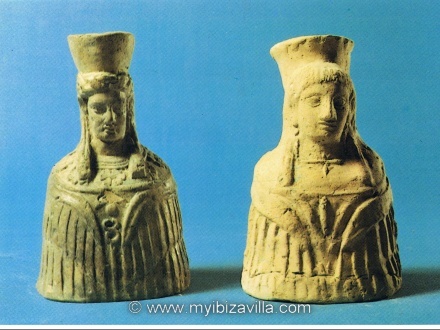
- 600 terracota figures, the most well known bell shaped figures are feminine, and have diverse symbols sketched on them;
in a few cases they have their faces covered by a fine layer of gold.
- A thousand figureheads and ceramic fragments.
- As well as other materials such as bone or ivory lion.
- One of the most important objects though, a plaque with a double Punic inscription was found by chance in 1923 and it is now at the Provincial Archaeological Museum
of Alicante. On the oldest face, it says: To the brd, to Resef-Melkart, this sanctuary dedicated by 's'dr, son of
Ya'as ay, son of brgd, son of Eshmunhilles. And on the most modern face, it says: This
wal! of sculpted stone has been built, dedicated and repaired by Abdeshmun, son of Azarbaal, the priest, to our lady, to Tanit the powerful and to Gad, on his own.
Some of the archaeological finds discovered in the cave are now on display in the Museo Monográfico del Puig des Molins in Ibiza.
In a discontinuous manner, and until 1981, this very important site, cave es Cuieram,
knew archaeological interventions of different kind, among which unfortunately, some clandestine.
Presently Cova d'es Cuieram belongs to Ibiza and Formentera Insular Council.
A whole system of collapsed stone blocks, from the first natural room whose fall threatened to definitely ruin the monument, was shored up by the owning Institution.
Apart from a pre-historical period, — when the cave es Cuieram was probably the home for an inhabitants group of the bronze age and which seems not to
have continuity until the Phoenician-Punic period — since the 5th century bC., the cave d'es Cuieram became a Sanctuary first dedicated to Reseph-Melkart and after,
on 3rd or 2nd century, to Tanit.
Some artificial modifications which can be seen on the monument correspond to the late period: a part of an artificial room with its back
sculpted in the rock and next to it the bottom of a typical Punic tank, have been preserved.
The sanctuary was located in a big natural cavity which water circulation had subdivided in different rooms, especially two big ones separated by a
stalactites curtain. One can still see said artificial works as well at the entrance.
The cave es Cuieram has a huge domed roof and two floor levels. On the lower level there is a flat rock that was probably used for sacrifices.
As for the chronology of the temple, the experts think that the bed was used from the end of the 5th century until the 2nd century bC.
According to information supplied by first excavators, information which has been recently revised, one must think
that the deep rooms were a kind of botrhos — a sacred deposit — where rests of sacrifice tributes were left.
These were carried out through divine figures — which in a very high percentage represent Tanit's bust covered with a shawl with wings — as well
as the rests of the many animals consumed upon the sacrifice and obviously other objects. Said rites which entailed the use
of fire, had to logically take place outside the sanctuary or in its hall area.
At the time of the worship carried out at es Culleram temple, all sa Cala channel had many population and it is obvious that
these would be the people directly involved in said worship.
Notwithstanding, at the same time, it had to be an international sanctuary, well connected with sea as it was through sa Cala harbour.
In times gone by, reed plantations reached right down to the sea and the area was one of the spots of most primitive beauty.
The cave was then a place of funeral rites to ensure safe passage to the after-life for the loved ones of the rugged island survivors.
As an organized temple at least, it was almost abandoned in the advanced 2nd century bC. It might well be that the natural
collapse of the first big room of the cave was the reason for the end of worship at es Culleram Punic sanctuary.
Move over the small images to enlarge them !
You can get to the cave by following the signs on the Cala de San Vicente road in the north of the island. (the red line on the Google map)
It's about a 5 min. drive from your
rental Ibiza villa. You can do part of the trip by car, but the last section has to be done on foot.
If you have the energy for a long walk, you can also go down through the pinewoods to the sea from the cave.
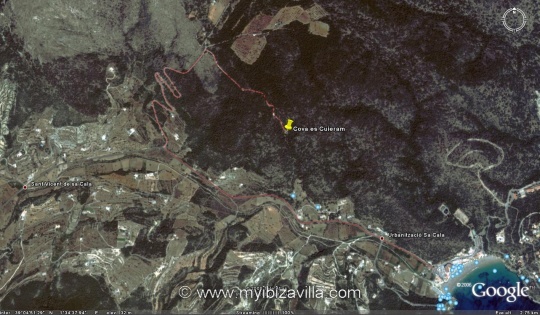 Cova d'es Cuieram
Carretera Cala Sant Vicenç
07811 Sant Juan / Ibiza
Visitor's timetable: 9:30 am to 1:30 pm From Tuesday to Saturday
This archeological Ibiza cave es Cuieram has still a free entrance!
But please help us, telling the world about this historic cave by using one of these websites:
Cova d'es Cuieram
Carretera Cala Sant Vicenç
07811 Sant Juan / Ibiza
Visitor's timetable: 9:30 am to 1:30 pm From Tuesday to Saturday
This archeological Ibiza cave es Cuieram has still a free entrance!
But please help us, telling the world about this historic cave by using one of these websites:

 Or bookmark this page via:
Or bookmark this page via:



 Spurl
Blinkbits
deliriuos
feedmelinks
Simpy
Spurl
Blinkbits
deliriuos
feedmelinks
Simpy
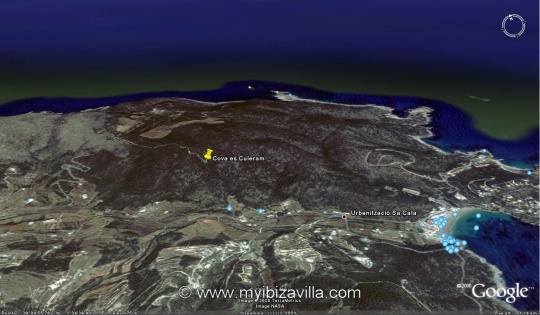
Tanit
For many of us, the Punic goddess Tanit has become a symbol of Ibiza.
Even though we find Tanits picture all over the island, i.e:. Autos Tanit. Bar Tanit or in the ads for
Marí Mayans spirits, we really know very little about this goddess.
Who is Tanit? She is a Carthaginian goddess.
Carthaginians are people from the North African city of Carthage, part of the Phoenician empire.
The Phoenician empire was an empire just like the Greek and Roman ones except its base was North Africa.
At its peak the empire stretched across the whole Mediterranean. Its centre was originally a city called Tyre, but power
eventually shifted to Carthage on the coast of what is now Tunisia.
The Romans eventually destroyed the Carthaginian Empire in the Punic wars and they did a very effective job in wiping out any records of its culture.
In 654 bC the Carthaginians arrived in Ibiza and founded a trading post. They gave Ibiza the name Ibosim and eventually settled over the whole island.
Tanit, (known as the fertility goddess) arrived with the Phoenicians about 700 years ago where it was worshipped by the population.
Tanits powers included different areas; it was the owner of the sky, the moon, fertility and war.
Tanit was worshipped as a goddess that united the earth with the sky. Its masculine equivalent was known as Baal-Hammon, whose presence we
find in many ancient religions of the Middle East. It was also known as the rain goddess, whose mercy was invoked sacrificing doves and sheep.
Its symbols ware the pomegranate, dove and the lion.
Unfortunately very little about the cult and mythology of Tanit is found in ancient writings. Due to this,
many archaeologists think that it was known under different names because there are many parallels between other ancient goddesses.
Its predecessor was Astarté, the goddess of love, whose origins go back to Ishtar and the Babylonian area. Later under Roman influence,
Tanit became the goddess Juno. Also, many people compare Tanit to the Greek goddess Demeter or Heres, the wife of Zeus which leads us to the conclusion
that there are many different names for the divine aspect of the feminine.
The largest Tanit temple excavations are being done in the north of Africa.
Here in Ibiza, the sanctuary is the Es Cuieram cave in the northeast of the island where one can still detect the goddess's presence.
Also on the outskirts of Ibiza Town in a place called Puig dels Molins there is a vast Carthaginian cemetery with more than 2,000 tombs.
In many of them, statues of Tanit have also been found.
Do people still worship Tanit? People still leave offerings for her in the cave.
Tanit was also woshipped on Sardinia and Malta.
IBOSIM: The island of Bes.
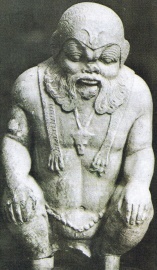
Ibosim is one of Ibiza's oldest names. Translated from the Punic language this word means "island of Bes".
The midget guardian God, who was also worshipped in Egypt, was brought to Ibiza about 1500 bC through Punic influence.
His exact origin is unknown to us and many experts think, he originally came (descended) from the Pygmies, because his appearance
is very different from Mediterranean and Egyptian Gods.
He was not especially a beauty. A midget person with long arms, short legs, snub nosed face, bushy beard and big eyebrows.
Most of the time he is shown with a hanging tongue, horns and hoofs. In some pictures you can also see him with a giant penis.
Because of his appearance, very often he was associated with the Capricorn or the God Pan.
Despite his grotesque look he found strong reverence in Ibiza and he was associated with many good qualities.
Bes brought luck into the houses of all social levels and he was the protector of the marriage and family.
He took care of the women's needs and their jewelry. He was their biggest friend and helped them through birth giving.
Very often you find illustrations of him dancing around the young mother with drums, tambourines and waving knifes.
The noise, the horrible laughing and his ugly face where supposed to scare off bad spirits and protect the newly born baby.
Also you found his picture over beds, because he was the caretaker (protector) of sleep.
He was seen as an important magician and on many old coins from Ibiza we can find this little bearded figure fighting with a snake.
"Bes the curse of all bad creatures," he was often called because he also protected his followers against dangerous animals.
Many people believe, that the absence of poisonous animals on Ibiza is due to him.
But first of all he was the God of good moods and pleasure. Already in old Egypt he was
dancing in front of the pharaohs giving them pleasure with the sound of harps,
lyre and tambourines. Therefore dance and music were an important part of his cult, clearly his influence still continues in Ibiza.

